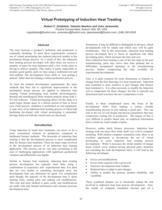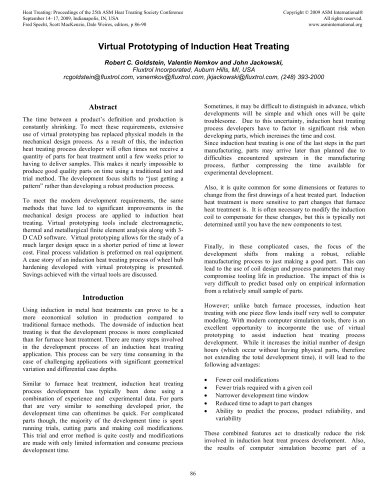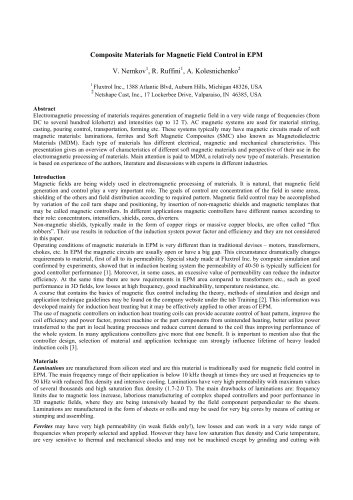 Website:
Fluxtrol, Inc.
Website:
Fluxtrol, Inc.
Catalog excerpts

Heat Treating: Proceedings of the 25th ASM Heat Treating Society Confrence September 14-17, 2009, Indianapolis, IN, USA Fred Specht, Scott MacKenzie, Dale Weires, editors, p 86-90 Copyright © 2009 ASM International® All rights reserved. www.asminternational.org Virtual Prototyping of Induction Heat Treating Robert C. Goldstein, Valentin Nemkov and John Jackowski, Fluxtrol Incorporated, Auburn Hills, MI, USA rcgoldstein@fluxtrol.com, vsnemkov@fluxtrol.com, jkjackowski@fluxtrol.com, (248) 393-2000 Abstract The time between a product's dfinition and production is constantly shrinking. To meet these requirements, extensive use of virtual prototyping has replaced physical models in the mechanical design process. As a result of this, the induction heat treating process developer will often times not receive a quantity of parts for heat treatment until a few weeks prior to having to deliver samples. This makes it nearly impossible to produce good quality parts on time using a traditional test and trial method. The development focus shifts to "just getting a pattern" rather than developing a robust production process. To meet the modern development requirements, the same methods that have led to significant improvements in the mechanical design process are applied to induction heat treating. Virtual prototyping tools include electromagnetic, thermal and metallurgical finite element analysis along with 3-D CAD software. Virtual prototyping allows for the study of a much larger design space in a shorter period of time at lower cost. Final process validation is preformed on real equipment. A case story of an induction heat treating process of wheel hub hardening developed with virtual prototyping is presented. Savings achieved with the virtual tools are discussed. Sometimes, it may be difficult to distinguish in advance, which developments will be simple and which ones will be quite troublesome. Due to this uncertainty, induction heat treating process developers have to factor in significant risk when developing parts, which increases the time and cost. Since induction heat treating is one of the last steps in the part manufacturing, parts may arrive later than planned due to difficulties encountered upstream in the manufacturing process, further compressing the time available for experimental development. Also, it is quite common for some dimensions or features to change from the first drawings of a heat treated part. Induction heat treatment is more sensitive to part changes that furnace heat treatment is. It is often necessary to modify the induction coil to compensate for these changes, but this is typically not determined until you have the new components to test. Finally, in these complicated cases, the focus of the development shifts from making a robust, reliable manufacturing process to just making a good part. This can lead to the use of coil design and process parameters that may compromise tooling life in production. The impact of this is very difficult to predict based only on empirical information from a relatively small sample of parts. However; unlike batch furnace processes, induction heat treating with one piece flow lends itself very well to computer modeling. With modern computer simulation tools, there is an excellent opportunity to incorporate the use of virtual prototyping to assist induction heat treating process development. While it increases the initial number of design hours (which occur without having physical parts, therefore not extending the total development time), it will lead to the following advantages: 驕 Fewer coil modifications Fewer trials required with a given coil Օ Narrower development time window Reduced time to adapt to part changes Օ Ability to predict the process, product reliability, and variability These combined features act to drastically reduce the risk involved in induction heat treat process development. Also, the results of computer simulation become part of a Introduction Using induction in metal heat treatments can prove to be a more economical solution in production compared to traditional furnace methods. The downside of induction heat treating is that the development process is more complicated than for furnace heat treatment. There are many steps involved in the development process of an induction heat treating application. This process can be very time consuming in the case of challenging applications with significant geometrical variation and differential case depths. Similar to furnace heat treatment, induction heat treating process development has typically been done using a combination of experience and experimental data. For parts that are very similar to something developed prior, the development time can oftentimes be quick. For complicated parts though, the majority of the development time is spent running trials, cutting parts and making coil modifications. This trial and error method is quite costly and modifications are made with only limited information and consume precious development time. 86
Open the catalog to page 1
detailed record of the relationship between product characteristics and system parameters. These records may be referenced in the event a problem occurs during production. Induction Heat Treat Process Development Using Virtual Prototyping The stages of development for an induction heat treat process vary depending upon the circumstances. In the most complete case, brand new components for induction heat treating and developing a process using virtual prototyping includes the following steps: 1. Preliminary analysis of the specifications and available equipment. 2. Preliminary process design...
Open the catalog to page 2
An examination of a failed coil showed that copper cracking occurred directly under the laminations due to overheating. Degradation of the laminations also occurred, but was not the reason the coil was taken out of production. The part producer contacted their vendor and several attempts of corrective action were made. The internal water cooling flow rate was increased, but did not resolve the situation. The laminations in this section of the coil were replaced by Fluxtrol A magnetic concentrator. With the same heat pattern and machine settings, the coil lifetime increased to 15,000 -...
Open the catalog to page 3All Fluxtrol catalogs and technical brochures
-
Ferrotron 559H
2 Pages
-
Fluxtrol 50
2 Pages
-
Fluxtrol 25
2 Pages
-
Fluxtrol Brochure
8 Pages
-
Alphaform LF
1 Pages
-
FLUXTROL-A
1 Pages
-
Fluxtrol 100
1 Pages
-
Fluxtrol's AlphaForm
30 Pages
-
fluxtrol Catalog
59 Pages












